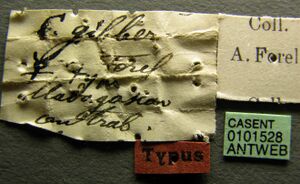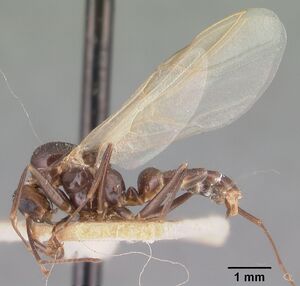Camponotus gibber
| Camponotus gibber | |
|---|---|

| |
| Scientific classification | |
| Kingdom: | Animalia |
| Phylum: | Arthropoda |
| Class: | Insecta |
| Order: | Hymenoptera |
| Family: | Formicidae |
| Subfamily: | Formicinae |
| Tribe: | Camponotini |
| Genus: | Camponotus |
| Subgenus: | Myrmosaga |
| Species: | C. gibber |
| Binomial name | |
| Camponotus gibber Forel, 1891 | |
Camponotus gibber occurs in mid-altitude rainforest, montane rainforest, open areas on the forest edge, and the savannah grassland of the high plateau of Madagascar. Its distribution ranges from the RS Manongarivo and PN Marojejy in the north through the Corridor Forestier Analamay-Mantadia and PN Andringitra in the south-central region to the PN Andohahela and Anosyenne Mountains in the south. It has also colonized the littoral rainforest of Ambondrobe Vohemar, the dry forest of the PN Isalo, and cultivated land in the Andrambovato Forest (Fig. 53D). Individual workers forage mostly on the ground and through leaf litter, and rarely on lower vegetation. Nests are typically in rotten logs and rotting tree stumps, but seldom in the ground, in root mats on the ground, in dead twigs above the ground, in moss and leaf litter on live trees, and under tree bark.
Identification
In full-face view, lateral margins of head anterior to eye level diverging posteriorly; anterior clypeal margin truncate; two pairs of white spots present on second and third abdominal tergites; pronotum, mesonotum, and propodeum forming separate convexities, metanotal groove depressed; level of propodeum lower than that of promesonotum.
Camponotus gibber may be difficult to differentiate from Camponotus rotrae and Camponotus quadrimaculatus in that they have two pairs of white spots on the second and third abdominal tergites. In both latter species, however, the pronotum, mesonotum, and propodeum do not form separate convexities, the metanotal groove is not depressed, and the dorsal face of its petiolar node joins the posterior face at an angle.
There are apparently three forms within C. gibber. These are geographically isolated across their distribution along the eastern rainforest of Madagascar due to the presence of high mountain chains in northwestern Madagascar. In the first form, the mesosoma strongly forms separate convexities and the propodeal dorsum is more or less straight. The second form is characterized by a more or less continuous dorsal outline of the mesosoma and a broadly concave propodeal dorsum. The third form constitutes intermediate degrees of these phenotypic variations because workers present separate convexities of mesosoma and a slightly concave propodeal dorsum. The members of the first two forms show morphological variabilities that gradually merge in the third form.
Keys including this Species
Distribution
Distribution based on Regional Taxon Lists
Malagasy Region: Madagascar (type locality).
Distribution based on AntMaps
Distribution based on AntWeb specimens
Check data from AntWeb
Countries Occupied
| Number of countries occupied by this species based on AntWiki Regional Taxon Lists. In general, fewer countries occupied indicates a narrower range, while more countries indicates a more widespread species. |

|
Estimated Abundance
| Relative abundance based on number of AntMaps records per species (this species within the purple bar). Fewer records (to the left) indicates a less abundant/encountered species while more records (to the right) indicates more abundant/encountered species. |

|
Biology
Castes
Images from AntWeb
   
| |
| Worker (major/soldier). Specimen code casent0101440. Photographer April Nobile, uploaded by California Academy of Sciences. | Owned by MNHN, Paris, France. |
    
| |
| Lectotype of Camponotus gibber. Worker. Specimen code casent0101513. Photographer Michele Esposito, uploaded by California Academy of Sciences. | Owned by MHNG, Geneva, Switzerland. |
   
| |
| Paralectotype of Camponotus gibber. Worker (major/soldier). Specimen code casent0101528. Photographer April Nobile, uploaded by California Academy of Sciences. | Owned by MHNG, Geneva, Switzerland. |
    
| |
| Male (alate). Specimen code casent0101536. Photographer April Nobile, uploaded by California Academy of Sciences. | Owned by MHNG, Geneva, Switzerland. |
   
| |
| Paralectotype of Camponotus gibber. Queen (alate/dealate). Specimen code casent0101537. Photographer April Nobile, uploaded by California Academy of Sciences. | Owned by MHNG, Geneva, Switzerland. |
Nomenclature
The following information is derived from Barry Bolton's Online Catalogue of the Ants of the World.
- gibber. Camponotus quadrimaculatus var. gibber Forel, 1891b: 59 (s.) MADAGASCAR.
- Forel, 1891b: 215 (w.); Forel, 1892l: 232 (q.m.); Forel, 1892l: 232 (q.m.).
- Combination in C. (Myrmosphincta): Forel, 1914a: 273;
- combination in C. (Mayria): Emery, 1925b: 122.
- Status as species: Forel, 1891b: 215; Forel, 1892l: 232; Dalla Torre, 1893: 232; Emery, 1896d: 374 (in list); Wheeler, W.M. 1922a: 1054; Emery, 1925b: 122; Bolton, 1995b: 101; Rakotonirina & Fisher, 2022: 83.
Type Material
- Lectotype minor worker, designated by Rakotonirina & Fisher, 2022: 83, Madagascar, Andrangoloaka (Sikora) AntWeb CASENT0101513 (MHNG).
- Paralectotype. 1 minor worker and 1 alate queen of same data as lectotype but with the following specimen codes: CASENT0101528, CASENT0101537 (MHNG) [Rakotonirina & Fisher, 2022].
Description
References
- Emery, C. 1925d. Hymenoptera. Fam. Formicidae. Subfam. Formicinae. Genera Insectorum 183: 1-302 (page 122, Combination in C. (Mayria))
- Forel, A. 1891c. Les Formicides. [part]. In: Grandidier, A. Histoire physique, naturelle, et politique de Madagascar. Volume XX. Histoire naturelle des Hyménoptères. Deuxième partie (28e fascicule). Paris: Hachette et Cie, v + 237 pp. (page 215, Raised to species)
- Forel, A. 1891c. Les Formicides. [part]. In: Grandidier, A. Histoire physique, naturelle, et politique de Madagascar. Volume XX. Histoire naturelle des Hyménoptères. Deuxième partie (28e fascicule). Paris: Hachette et Cie, v + 237 pp. (page 215, worker described)
- Forel, A. 1891c. Les Formicides. [part]. In: Grandidier, A. Histoire physique, naturelle, et politique de Madagascar. Volume XX. Histoire naturelle des Hyménoptères. Deuxième partie (28e fascicule). Paris: Hachette et Cie, v + 237 pp. (page 59, soldier described)
- Forel, A. 1892o. Les Formicides. [concl.]. In: Grandidier, A. Histoire physique, naturelle, et politique de Madagascar. Volume XX. Histoire naturelle des Hyménoptères. Deuxième partie. Supplèment au 28e fascicule. Paris: Hachette et Cie, pp. 229-280. (page 232, queen, male described)
- Forel, A. 1914a. Le genre Camponotus Mayr et les genres voisins. Rev. Suisse Zool. 22: 257-276 (page 273, Combination in C. (Myrmosphincta))
- Rakotonirina, J.C., Fisher, B.L. 2022. Revision of the Malagasy Camponotus subgenus Myrmosaga (Hymenoptera, Formicidae) using qualitative and quantitative morphology. ZooKeys 1098: 1–180 (doi:10.3897/zookeys.1098.73223).
- Wheeler, W. M. 1922k. Ants of the American Museum Congo expedition. A contribution to the myrmecology of Africa. IX. A synonymic list of the ants of the Malagasy region. Bull. Am. Mus. Nat. Hist. 4 45: 1005-1055 (see also)
References based on Global Ant Biodiversity Informatics
- Fisher B. L. 1997. Biogeography and ecology of the ant fauna of Madagascar (Hymenoptera: Formicidae). Journal of Natural History 31: 269-302.
- Fisher B. L. 2003. Formicidae, ants. Pp. 811-819 in: Goodman, S. M.; Benstead, J. P. (eds.) 2003. The natural history of Madagascar. Chicago: University of Chicago Press, xxi + 1709 pp.
- Wheeler W. M. 1922. Ants of the American Museum Congo expedition. A contribution to the myrmecology of Africa. IX. A synonymic list of the ants of the Malagasy region. Bulletin of the American Museum of Natural History 45: 1005-1055

